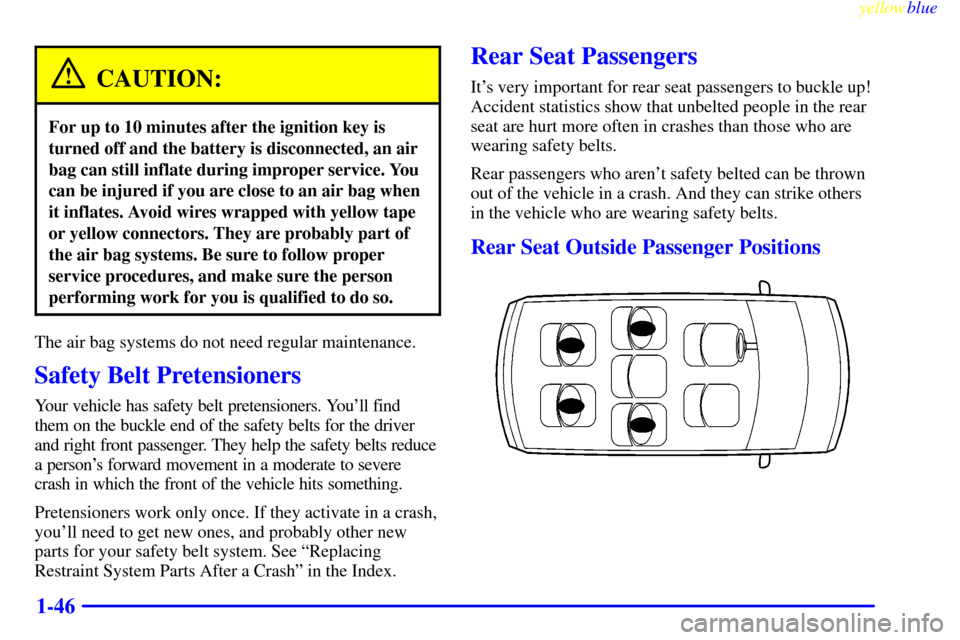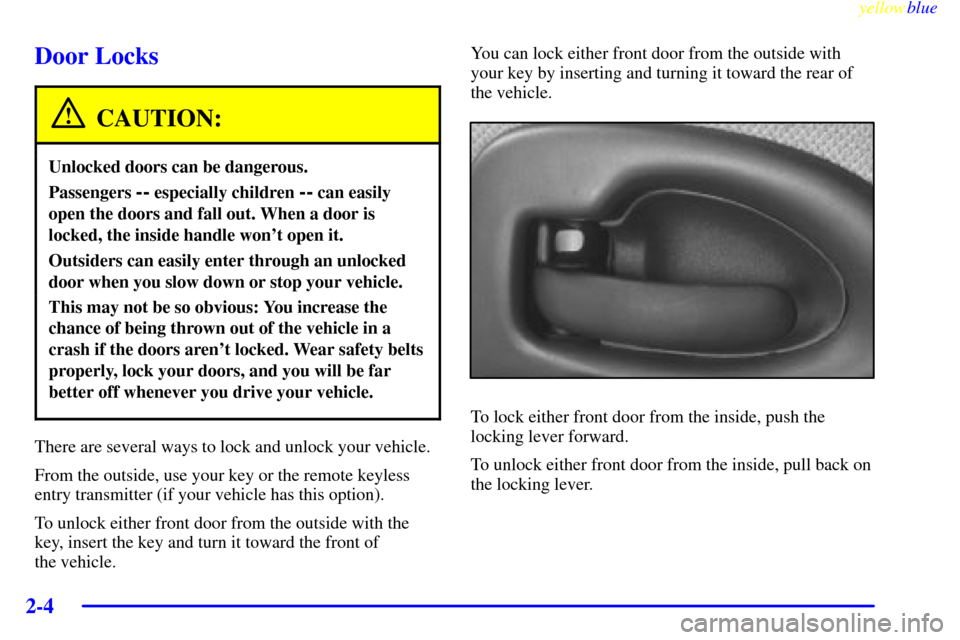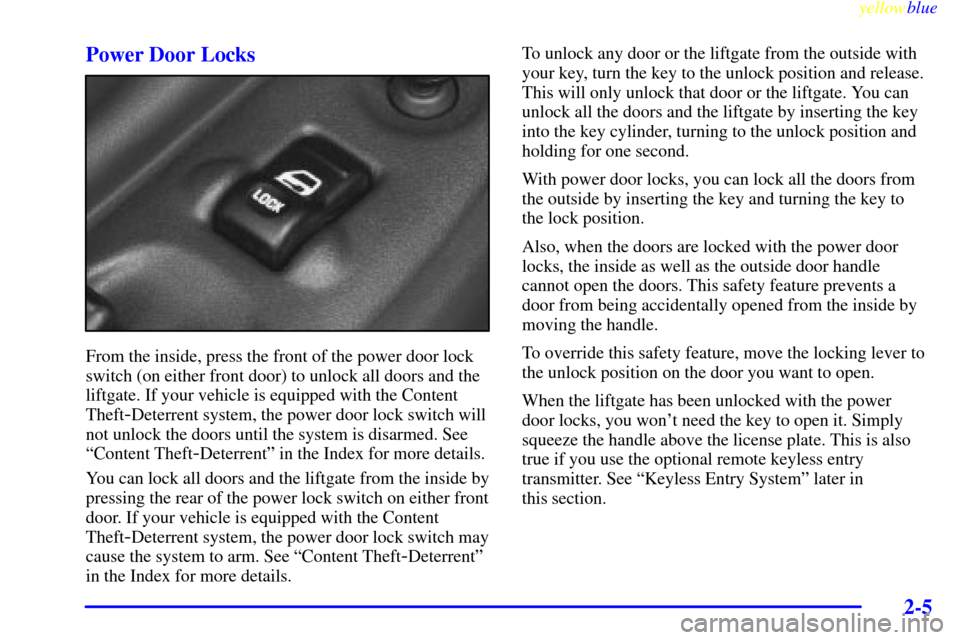Page 18 of 440
yellowblue
1-10
Removing the Split Bench Seat
Make sure the seatback is in the upright position and
that the safety belts are on the correct section of the seat.
The head restraints should be fully down.
1. For the second row split bench, with the seatback in
the upright position, unhook the side attachment for
the safety belt. This mini
-buckle is located on the
right side of the seat.
2. Push the red center of
the buckle up with a
small pointed
object
-- like a key or a
pen to remove the seat
belt, if needed.
3. Lift the seatback recliner lever or pull the nylon strap
on the back of the seat to fold the seatback forward.
4. Slide the seat all the way back by lifting either one of
the adjustment bars and sliding the seat
fully rearward.
5. From behind the bench seat, pull the nylon strap at
the base of the seat to release the rear latches from
the floor pins.
Do not let go of the straps until the seat is folded all
the way forward.
Page 45 of 440

yellowblue
1-37
The best way to protect the fetus is to protect the
mother. When a safety belt is worn properly, it's more
likely that the fetus won't be hurt in a crash. For
pregnant women, as for anyone, the key to making
safety belts effective is wearing them properly.
Right Front Passenger Position
To learn how to wear the right front passenger's safety
belt properly, see ªDriver Positionº earlier in
this section.
The right front passenger's safety belt works the same
way as the driver's safety belt
-- except for one thing.
If you ever pull the shoulder portion of the belt out all
the way, you will engage the child restraint locking
feature. If this happens, just let the belt go back all the
way and start again.
Air Bag Systems
This part explains the frontal and side impact air
bag systems.
Your vehicle has four air bags
-- a ªNext Generationº
frontal air bag for the driver, another ªNext Generationº
frontal air bag for the right front passenger, a side
impact air bag for the driver, and another side impact air
bag for the right front passenger.
Next Generation frontal air bags are designed to help
reduce the risk of injury from the force of an inflating
frontal air bag. But even these air bags must inflate very
quickly if they are to do their job and comply with
federal regulations.
Page 54 of 440

yellowblue
1-46
CAUTION:
For up to 10 minutes after the ignition key is
turned off and the battery is disconnected, an air
bag can still inflate during improper service. You
can be injured if you are close to an air bag when
it inflates. Avoid wires wrapped with yellow tape
or yellow connectors. They are probably part of
the air bag systems. Be sure to follow proper
service procedures, and make sure the person
performing work for you is qualified to do so.
The air bag systems do not need regular maintenance.
Safety Belt Pretensioners
Your vehicle has safety belt pretensioners. You'll find
them on the buckle end of the safety belts for the driver
and right front passenger. They help the safety belts reduce
a person's forward movement in a moderate to severe
crash in which the front of the vehicle hits something.
Pretensioners work only once. If they activate in a crash,
you'll need to get new ones, and probably other new
parts for your safety belt system. See ªReplacing
Restraint System Parts After a Crashº in the Index.
Rear Seat Passengers
It's very important for rear seat passengers to buckle up!
Accident statistics show that unbelted people in the rear
seat are hurt more often in crashes than those who are
wearing safety belts.
Rear passengers who aren't safety belted can be thrown
out of the vehicle in a crash. And they can strike others
in the vehicle who are wearing safety belts.
Rear Seat Outside Passenger Positions
Page 101 of 440

2-
yellowblue
2-1
Section 2 Features and Controls
Here you can learn about the many standard and optional features on your vehicle, and information on starting,
shifting and braking. Also explained are the instrument panel and the warning systems that tell you if everything is
working properly
-- and what to do if you have a problem.
2
-2 Keys
2
-4 Door Locks
2
-7 Keyless Entry System (Option)
2
-13 Multifunction Alarm Locks and
Lighting Choices
2
-23 Sliding Door
2
-25 Power Sliding Door (Option)
2
-31 Liftgate
2
-32 Theft
2
-33 Content Theft-Deterrent (Option)
2
-35 PASS-Key� III
2
-37 New Vehicle ªBreak-Inº
2
-38 Ignition Positions
2
-40 Starting Your Engine
2
-41 Engine Coolant Heater (If Equipped)
2
-43 Automatic Transaxle Operation
2
-47 Parking Brake
2
-48 Shifting Into PARK (P)2
-50 Shifting Out of PARK (P)
2
-51 Parking Over Things That Burn
2
-52 Engine Exhaust
2
-52 Running Your Engine While You're Parked
2
-53 Windows
2
-55 Turn Signal/Multifunction Lever
2
-61 Exterior Lamps
2
-63 Interior Lamps
2
-66 Mirrors
2
-68 Storage Compartments
2
-79 Sun Visors
2
-80 OnStar System� (Option)
2
-80 Accessory Inflator System (Option)
2
-83 Accessory Power Outlets
2
-84 The Instrument Panel -- Your
Information System
2
-88 Warning Lights, Gages and Indicators
2
-102 Driver Information Center (DIC) (Option)
Page 102 of 440
yellowblue
2-2
Keys
CAUTION:
Leaving children in a vehicle with the ignition
key is dangerous for many reasons. A child or
others could be badly injured or even killed.
They could operate power windows or other
controls or even make the vehicle move. Don't
leave the keys in a vehicle with children.
Page 103 of 440
yellowblue
2-3
The master key can be
used for the ignition
as well as all door locks,
the liftgate lock and the
storage compartments.
If you need a new key, contact your Chevrolet dealer,
who can obtain the correct key code. In an emergency,
call Chevrolet Roadside Assistance at
1
-800-CHEV-USA� (1-800-243-8872).
(In Canada, call 1
-800-268-6800.)
NOTICE:
Your vehicle has a number of new features that
can help prevent theft. But you can have a lot of
trouble getting into your vehicle if you ever lock
your key inside. You may even have to damage
your vehicle to get in. So be sure you have an
extra key.
Page 104 of 440

yellowblue
2-4
Door Locks
CAUTION:
Unlocked doors can be dangerous.
Passengers -- especially children -- can easily
open the doors and fall out. When a door is
locked, the inside handle won't open it.
Outsiders can easily enter through an unlocked
door when you slow down or stop your vehicle.
This may not be so obvious: You increase the
chance of being thrown out of the vehicle in a
crash if the doors aren't locked. Wear safety belts
properly, lock your doors, and you will be far
better off whenever you drive your vehicle.
There are several ways to lock and unlock your vehicle.
From the outside, use your key or the remote keyless
entry transmitter (if your vehicle has this option).
To unlock either front door from the outside with the
key, insert the key and turn it toward the front of
the vehicle.You can lock either front door from the outside with
your key by inserting and turning it toward the rear of
the vehicle.
To lock either front door from the inside, push the
locking lever forward.
To unlock either front door from the inside, pull back on
the locking lever.
Page 105 of 440

yellowblue
2-5
Power Door Locks
From the inside, press the front of the power door lock
switch (on either front door) to unlock all doors and the
liftgate. If your vehicle is equipped with the Content
Theft
-Deterrent system, the power door lock switch will
not unlock the doors until the system is disarmed. See
ªContent Theft
-Deterrentº in the Index for more details.
You can lock all doors and the liftgate from the inside by
pressing the rear of the power lock switch on either front
door. If your vehicle is equipped with the Content
Theft
-Deterrent system, the power door lock switch may
cause the system to arm. See ªContent Theft
-Deterrentº
in the Index for more details.To unlock any door or the liftgate from the outside with
your key, turn the key to the unlock position and release.
This will only unlock that door or the liftgate. You can
unlock all the doors and the liftgate by inserting the key
into the key cylinder, turning to the unlock position and
holding for one second.
With power door locks, you can lock all the doors from
the outside by inserting the key and turning the key to
the lock position.
Also, when the doors are locked with the power door
locks, the inside as well as the outside door handle
cannot open the doors. This safety feature prevents a
door from being accidentally opened from the inside by
moving the handle.
To override this safety feature, move the locking lever to
the unlock position on the door you want to open.
When the liftgate has been unlocked with the power
door locks, you won't need the key to open it. Simply
squeeze the handle above the license plate. This is also
true if you use the optional remote keyless entry
transmitter. See ªKeyless Entry Systemº later in
this section.